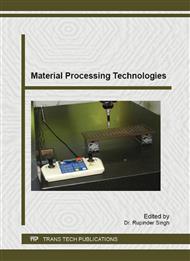[1]
R. Kataria, J. Kumar, Machining of WC-Co composites- A review, Material Science Forum 808 (2015) 51–64.
DOI: 10.4028/www.scientific.net/msf.808.51
Google Scholar
[2]
P. Janmanee, A. Muttamara, Optimization of electrical discharge machining of composite 90WC-10Co base on Taguchi approach, European Journal of Scientific Research 64(3) (2011) 426–436.
Google Scholar
[3]
G.K. Singh, V. Yadav, R. Kumar, Diamond face grinding of WC-Co composite with spark assistance: Experimental study and parameter optimization, International Journal of Precision E4ngineering and Manufacturing 11 (2010) 509–518.
DOI: 10.1007/s12541-010-0059-3
Google Scholar
[4]
A.T.Z. Mahamat, A.M. A Rani, P. Husain, Machining of cemented tungsten carbide using EDM, Journal of Applied Sciences 11(10) (2011) 1784–1790.
DOI: 10.3923/jas.2011.1784.1790
Google Scholar
[5]
S.K.S. Yadav, V. Yadav, Experimental investigation to study electrical discharges diamond cutoff grinding (EDDCG) machinability of cemented carbide, Materials and Manufacturing Processes 28 (2013)1077–1081.
DOI: 10.1080/10426914.2013.792414
Google Scholar
[6]
S.N. Bhavsar, S. Aravindan, V. Rao, Machinability study of cemented carbide using focused ion beam (FIB) milling, Materials and Manufacturing Processes 27 (2012) 1029–1034.
DOI: 10.1080/10426914.2011.654166
Google Scholar
[7]
A. Mohanty, G. Talla, S. Gangopadhyay, Experimental investigation and analysis of EDM characteristics of Inconel 825, Materials and Manufacturing Processes 29(5) (2014) 540–549.
DOI: 10.1080/10426914.2014.901536
Google Scholar
[8]
R. Kataria, J. Kumar, B.S. Pabla, Experimental investigation into the hole quality in ultrasonic machining of WC-Co composite, Materials and Manufacturing Processes 31(5) (2015) 685-693.
DOI: 10.1080/10426914.2015.1037910
Google Scholar
[9]
R. Singh, J.S. Khamba, Investigation for ultrasonic machining of titanium and its alloys, Journal of Materials Processing Technology 183 (2007) 363–367.
DOI: 10.1016/j.jmatprotec.2006.10.026
Google Scholar
[10]
R.S. Jadoun, P. Kumar, B.K. Mishra, R.C.S. Mehta, Optimization of process parameters for ultrasonic drilling (USD) of advanced engineering ceramics using Taguchi approach, Engineering Optimization 38(7) (2006) 771–787.
DOI: 10.1080/03052150600733962
Google Scholar
[11]
J. Kumar, J.S. Khamba, S.K. Mohapatra, An investigation into the machining characteristics of titanium using ultrasonic machining, International Journal of Machining and Machinabaility of Materials 3(1/2) (2008) 143–161.
DOI: 10.1504/ijmmm.2008.017631
Google Scholar
[12]
J. Kumar, Investigation into the surface quality and micro-hardness in the ultrasonic machining of titanium (ASTM GRADE-1), Journal of the Brazilian Society of Mechanical Sciences and Engineering 36 (2014) 807–823.
DOI: 10.1007/s40430-014-0130-6
Google Scholar
[13]
J. Kumar, Ultrasonic machining - A compressive review, Machining Science and Technology: An International Journal 17 (3) (2013) 325–379.
Google Scholar
[14]
P.J. Ross, Taguchi Techniques for Quality Engineering, McGraw Hill, (1996) New York.
Google Scholar


